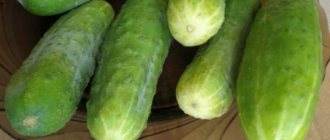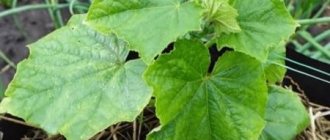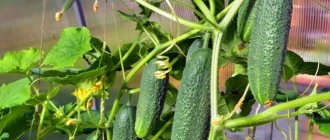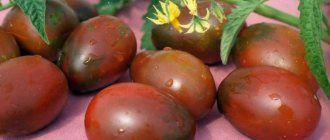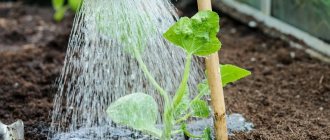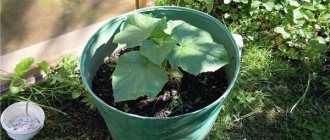Notice: Undefined variable: css_bg in /home/g/grigorig/prodachnika.com/public_html/wp-content/plugins/experts-by-webnavoz-1.3/experts-by-webnavoz.php on line 314 Notice: Undefined variable: out in /home/g/grigorig/prodachnika.com/public_html/wp-content/plugins/experts-by-webnavoz-1.3/experts-by-webnavoz.php on line 314 Notice: Undefined variable: css_market in /home/g/ grigorig/prodachnika.com/public_html/wp-content/plugins/experts-by-webnavoz-1.3/experts-by-webnavoz.php on line 322 Notice: Undefined variable: css_padding in /home/g/grigorig/prodachnika.com/ public_html/wp-content/plugins/vote2x/vote.php on line 100 Notice: Undefined variable: css_opacity in /home/g/grigorig/prodachnika.com/public_html/wp-content/plugins/vote2x/vote.php on line 101 Notice: Undefined index: prodachnika_comvote2x5595 in /home/g/grigorig/prodachnika.com/public_html/wp-content/plugins/vote2x/vote.php on line 118 Gardeners who constantly grow cucumbers on their plot in closed ground try to increase the time fruiting to maximum. There are several ways to get a positive result: provide proper care and purchase long-bearing hybrids.
Fruiting dates for greenhouse cucumbers
For cucumbers intended for greenhouses, there are significant differences in the timing of fruit harvest. The entire planned harvest from some varieties can be obtained very quickly, while from others it can take an order of magnitude longer. If the goal is to grow a bountiful harvest in a short period of time, then you should pay attention to quick-ripening varieties and hybrids. They can be called real sprinters in ripening greens. Since they begin to bear fruit very cooperatively, they can literally within a month from the beginning of the first ovaries give away almost the entire harvest that they are capable of, and this is up to 90-95% of its maximum amount. Their further development may be impractical; it is preferable to remove such plants and plant new seeds.
Long-term fruiting hybrids are a different matter. Here the situation is completely different. The cucumber harvest will be extended over several months, the bushes will bear fruit without interruption. In this case, the fruits can be collected little by little, but constantly.
Of course, mass and one-time collection of fruits is more suitable for industrial cultivation for sale. In small private greenhouses, gardeners prefer gradual and longer collection of fresh produce.
Seed preparation
Before sowing, seeds are hardened and kept in a growth stimulator. For hardening, dry seeds are placed in a damp gauze bag and placed in the refrigerator for 2 days, setting the temperature to 0 degrees. Seeds should not be allowed to germinate here, otherwise the hatched roots will die.
The next stage is a growth stimulator solution in which the seeds are kept for 2-3 hours. Energen, Epin, HB-101, Krezacin or aloe juice are suitable. For weekly spraying of seedlings, use Epin, Rostock or Lignohumate.
Stage 3 – germination in a damp environment (in a cloth or cotton pads) in a warm place where 25-28 degrees Celsius. You will have to wait 1-3 days for the sprouts. Seeds in a colored shell are not soaked or germinated.
What affects the timing of harvest?
It turns out that the timing of harvest is largely related to the branching characteristic of the cucumber vine, that is, its ability to grow lateral shoots. Hybrids with strong formation of lateral shoots show longer fruiting periods. Such properties are genetically determined in plants.
The thing is that in cucumbers with weak branching, the greens are tied on the main stem. When the harvest is harvested, the plant no longer has the opportunity to develop further; if the side shoots grow, they are very short and in small quantities; practically no new female flowers appear on them. The situation is different with those plants that intensively form side shoots. After harvesting the main stem, they begin a second wave of greens on the side branches. In greenhouses, such shoots, ready to grow from each internode, have to be pinched so that the plants do not interfere with each other.
Some similar hybrids (“Buyan”, “Okhotny Ryad”, “Chistye Prudy”, “Farmer”, “Anyuta”, etc.) have a very valuable feature - they are able to self-regulate branching. In this case, the side shoots do not begin to grow until the harvest is harvested from the main stem. This is very convenient for those who can only come to their dacha a couple of times a week, since the plantings do not have time to become very overgrown.
To obtain good and long-lasting autumn harvests from unheated greenhouses, you should pay attention to hybrids known for their cold resistance and shade tolerance (“Lord”, “Virenta”, “Spring Caprice”, “Moscow Nights”, “Saltan”, etc.). Some hybrids with moderate and weak branching (“Mazai”, “Kozyrnaya Karta”, “Ant”, etc.) show a fairly long fruiting period without forming strong lateral fouling.
Of course, varietal characteristics play a big role, however, much depends on environmental conditions. For example, severe shade, drought or cold inhibit the development of shoots. And vice versa, warmth, good lighting, timely watering and fertilizing increase it, respectively, increasing the yield.
Preparatory moments
The process of growing cucumbers begins with preparing a greenhouse or large greenhouse. Activities that need to be carried out before planting seedlings:
- Check the integrity of the structure - there should be no large gaps or cracks. If there are flaws in the walls or roof, they need to be repaired. This will help protect the cucumbers from drafts.
- The inside of the greenhouse must be treated with an antifungal agent. This must be done to avoid contamination of the soil and seedlings planted in it.
- Make a plan for the location of the beds.
- Choose a method for their formation.
You may also be interested in: Reasons why greenhouse and greenhouse cucumbers begin to turn yellow
It is recommended to adhere to the following scheme: placement along the structure. The width of the bed is from 50 cm. The passage between the beds is 90 cm. If the size of the greenhouse allows, you can use a location method that involves creating a small bed in the middle. If cultivation is planned in a cold climate, then it is best to make special heated floors in the greenhouse. There should also be a container of water for timely watering. The ventilation system is very important for cucumbers. You can arrange additional vents or use an automatic ventilation system.
Classification of varieties and hybrids
Today there is a real abundance of varieties and hybrids of cucumbers. Every year this number only increases. How not to get confused and choose the right one that suits specific conditions? Let's start with the classification:
- According to their taste and consumer characteristics, cucumbers can be divided into three groups - used for salads, for pickling and universal, that is, combining both first properties.
- Based on pollination, they are classified as bee-pollinated, parthenocarpic and self-pollinated.
- The length ranges from small pickles and gherkins to long ones – over 30 cm.
- The branching of the lashes is observed to be weak, medium and strong.
- By ripening period: early, middle and late.
- Based on the natural properties of the fruits, their different prickliness and tuberosity are known. The thorns of cucumbers can have colors - white, black and brown. It is believed that black-thorned ones are well suited for pickling. The tuberosity is distinguished between small and large; some smooth varieties do not have it at all.
- According to growing conditions: cucumbers suitable for soil, for greenhouses, hotbeds and universal. Note that hybrids for open ground can grow well in a greenhouse.
- In terms of yield, cucumbers have a long fruiting period and quick yield.
- Additional properties: shade-loving, drought- and frost-resistant, disease resistant.
When choosing which cucumbers to grow, you should pay attention to the following:
- where the cucumber will grow - in a greenhouse or in the ground;
- duration of fruiting;
- productivity;
- consumer properties of fruits.
Please note: do not sow greenhouse-only cucumbers in open ground beds. You can be left without a harvest or get a minimal amount of it.
Necessary elements for growing
In order to increase productivity and reduce the ripening time of fruits in closed ground conditions, two conditions must be met simultaneously: the greenhouse must be of suitable size, and it must contain all the necessary equipment for caring for plants. The greenhouse structure can be frame, film or polycarbonate. The latter is sealed, which allows you to maintain the microclimate created inside.
Minimum parameters: at least 10 m2 - area and 2 m - height.
The best long-term fruiting hybrids for greenhouses
"Anyuta F1". Bouquet, self-pollinating type, there are up to 5 ovaries per node, universal, with high resistance to many diseases. Greenery with an emerald color, tuberculate, white-thorned, frequent pubescence, tasty.
“Buyan F1”. A fast-ripening bouquet-type gherkin that forms up to 5 ovaries in a node. Cylindrical, universal, finely tuberculate, with small spines. Self-fertile, increased resistance to diseases, many vitamins.
"Virenta F1". Cold-resistant, self-pollinating cucumber, long fruiting, resistant to many diseases, quickly adapts to unfavorable conditions. The fruits are without bitterness, have infrequent tubercles with white spines, and are universal.
"Geek F1." Does not require pollination, early, bunch type, forms up to 6 green plants per node. Shows vigorous growth of the main stem with limited growth of side shoots. It is shade-tolerant, resistant to low temperatures and diseases. Greenweed is cylindrical, with stripes and sparse large tubercles, black thorns, universal. The cucumber pulp is juicy and not bitter.
"Lord F1". Early (ripens in 45 days), cold-resistant, long-term fruiting. Versatile, bee pollinated. The fruit is a long cylinder, bright in color, white-spiked, tasty.
"Matryoshka F1". Bundle-gherkin type of cucumber, forms up to 8 ovaries in a node. Early ripening, parthenocarpic, produces more ovaries in good light and is resistant to cold and disease. The greenery is bright in color, has stripes, tubercles, and white thorns. The shape is cylindrical-oval, the skin is dense, the pulp is juicy, excellent taste, universal use.
"Maryina Roshcha F1". Parthenocarpic, bouquet, early ripening type, forms up to 5 greens in a node. Characterized by cold resistance, strong branching, shade tolerance, good resistance to major diseases. Shows stable yields, regardless of conditions. The greens are large-tubercular, dense, white-thorned, aromatic, and versatile.
"Mazai F1". Early, gherkin type of cucumber. From germination to green plants - up to 45 days; a node forms 2-3 green plants. The fruit is an elongated cylinder with small tubercles. Excellent taste, versatile, resistant to major diseases, good yield - up to 14 kg per sq.m.
“At the command of the pike F1.” Mid-season, self-pollinating, bouquet type. Characteristically, the formation of lateral shoots is suppressed, but fruiting is extended. An interesting feature is that with full feeding at the end of summer, side shoots begin to grow with the formation of bouquets of three greens. The fruits are spindle-shaped, with large and sparse tubercles, the skin is dense, with crispy flesh.
"Moscow F1 Evenings". Mid-season, universal type, has excellent taste. Strongly climbing, with good shade tolerance. The fruit is cylindrical in shape, with medium tubercility, white spines.
"Saltan F1". Bouquet, gherkin type. Active branching, partially self-fertile, requires pollinator replanting. Fruits with large tubercles, white spines, frequent pubescence, universal, disease resistant.
"Farmer F1". It bears fruit for a long time, has a powerful root system and rapid growth of shoots. Bee-pollinated, nodes have 1-2 ovaries. Greens with dense pulp, stripes, large tubercles and white spines, universal type. Shows good disease resistance.
"Chic F1". Early, with strongly expressed parthenocarpy, bouquet type. Active and long-term fruiting, resistance to temperature changes and diseases. The greens are cylindrical, especially tasty when pickled.
"Chistye Prudy F1". Bundle type, with the formation of up to 6 ovaries per node. Cold-resistant, shade-tolerant, with complex resistance to diseases, the growth of vines is strong, the cucumber is universal. Cucumbers with tubercles and white spines, crispy, characteristically juicy, tasty.
Basic principles of temperature control
Cucumber is a tropical plant and requires sufficiently high air and soil temperatures for normal growth and development. The thermal optimum for growth depends primarily on the intensity of light and the phase of plant development; the temperature range is quite wide and ranges from +18 to +35°C.
Cucumber is very picky about heat conditions. Ensuring the correct temperature is important because, unlike the above-ground part of the cucumber, the root is unable to regulate its own heat. The optimal substrate temperature for growing cucumber is in the range of +22...+25°C, it should be relatively constant and show the lowest daily fluctuations.
A lower substrate temperature inhibits the growth and activity of roots, and therefore the absorption of moisture and minerals, especially phosphorus. This can cause the ovary to die and the plants to wilt. Reducing the heat of the substrate in the root zone to +10...+15°C disrupts the biochemical processes that determine the growth of the underground and above-ground parts of the cucumber. At lower soil temperatures, the cucumber root system can also become infected with root rot (Pythium debaryanum). The minimum thermal minimum of the soil is considered to be +13°C, and the maximum is +35°C.
Cucumber is a plant that is very sensitive to too large changes in thermal conditions, especially between day and night. Fluctuations should not exceed 6–8 degrees. The minimum temperature for a cucumber is considered to be +12°C, but plants begin to react to a drop in heat below +20°C, young cucumbers are especially sensitive to cold.
Did you know? Eating cucumbers may reduce the risk of developing certain types of cancer. It is believed that the ingredients contained in the vegetable may reduce the risk of breast, ovarian, colon and prostate cancer.
Chemical composition
Cucumber is a valuable low-calorie product (14 kcal per 100 g).
The vitamin component of the vegetable is not very expressive. Most of the ingredient composition is water (95%), which contains a natural adsorbent that absorbs and removes poisons from the body. This is a natural cleansing substance with a spectrum of action similar to activated carbon. Table No. 1 “Nutritional value of cucumber”
| Name | Concentration in 100 grams of raw materials, grams |
| Water | 95 |
| Carbohydrates | 2,5 |
| Mono- and disaccharides | 2,5 |
| Alimentary fiber | 1,0 |
| Squirrels | 0,8 |
| Ash | 0,5 |
| Pectin | 0,4 |
| Organic acids (tartaric, lactic) | 0,1 |
| Starch | 0,1 |
| Fats | 0,1 |
Table No. 2 “Chemical composition of cucumber”
| Name | Concentration in 100 grams of vegetable, milligram |
| Vitamins | |
| Ascorbic acid (C) | 10 |
| Pantothenic acid (B5) | 0,27 |
| Niacin (B3) | 0,2 |
| Alpha tocopherol (E) | 0,1 |
| Pyridoxine (B6) | 0,04 |
| Riboflavin (B2) | 0,04 |
| Thiamine (B1) | 0,03 |
| Beta carotene (A) | 0,005 |
| Folic acid (B9) | 0,004 |
| Biotin (H) | 0,0009 |
| Macronutrients | |
| Potassium | 141 |
| Phosphorus | 42 |
| Chlorine | 25 |
| Calcium | 23 |
| Magnesium | 14 |
| Sodium | 8 |
| Microelements | |
| Zinc | 0,22 |
| Manganese | 0,18 |
| Iron | 0,6 |
| Copper | 0,1 |
| Fluorine | 0,017 |
| Chromium | 0,006 |
| Iodine | 0,003 |
| Cobalt | 0,001 |
| Molybdenum | 0,001 |
Table No. 3 “Amino acid composition of cucumber”
| Name | Concentration in 100 grams of product, grams |
| Glutamic acid | 0,14 |
| Arginine | 0,05 |
| Aspartic acid | 0,05 |
| Leucine | 0,03 |
| Serin | 0,03 |
| Glycine | 0,03 |
| Valin | 0,03 |
| Lysine | 0,03 |
| Phenylalanine | 0,02 |
| Proline | 0,02 |
| Isoleucine | 0,02 |
| Threonine | 0,02 |
| Tyrosine | 0,02 |
| Histidine | 0,01 |
| Methionine | 0,01 |
| Tryptophan | 0,01 |
In addition to water, vitamins, minerals, carbohydrates, proteins and fiber, cucumbers contain polyphenols (secoisolariciresinol, lariciresinol, pinoresinol), which have an oncoprotective effect on the body.
Interestingly, on the island of Fiji, vegetables are considered the most valuable product, indicating human well-being. For example, the bride's parents do not consent to their daughter's marriage until the groom presents them with supplies of cucumbers.
Other tips
How to heat greenhouses?
You can do it yourself, or you can buy ready-made solutions. Heating systems can be divided into the following types:
The most common heating systems are stoves (potbelly stoves). This method was used to heat people in ancient times, but the method is still effective. The subject of combustion can be any flammable object. Leaves, manure and straw combinations (biofuel), wood, coal and much, much more.
First, we decide what is the most profitable way to heat our greenhouse, otherwise it makes no sense. After choosing the type of heating, we find a suitable scheme for installing a boiler (heater) ourselves or buy a ready-made solution in a store.
If you live in a region with low temperatures, it is necessary to perform additional insulation, which also includes insulation of the foundation.
How to properly illuminate a greenhouse?
Cucumbers need light. There should be no compromises here. With a lack of light, plants grow slower and are more susceptible to disease.
Do not use incandescent lamps to illuminate cucumbers. This is not only financially expensive, but can also cause damage to the plants (burns).
Amateur gardeners conducted tests with lighting, where LED lamps showed excellent results. The choice is yours.
Even at the planning stage of the greenhouse, it is necessary to make the maximum possible exposure to sunlight on the plants.
What area is needed for a greenhouse, what size is a standard one?
Everything is individual. There is no standard as such. You yourself look at the availability of free land or calculate the yield in kg per m2. The main thing is to be able to move without restricting movement. The height has its own standard of 2.2 m. This is the height at which you can safely walk and not worry about your head.
There should be plenty of space in the greenhouse, but do not forget that you need to heat it in cold weather (if you are going to get several harvests a year).
Conclusion
Cucumber is an annual vegetable grown in almost all countries of the world. The culture is valued for its aromatic unripe fruits (greens), used in cooking, diet therapy, folk medicine and cosmetology. In the food industry, cucumber is used as an independent snack and as part of summer salads, cold soups, and various pickles. Considering that the pulp of the fruit consists of 95% water, cucumber is an integral component of cleansing and detoxifying weight loss programs. Along with liquid, it contains vitamins, minerals, organic acids, tannins, flavonoids, dietary fiber, and adsorbents. The fruits of this crop perfectly satisfy hunger, potentiate the synthesis of thyroid hormones, help reduce swelling, stimulate intestinal contractility, increase the elasticity of blood vessels, and improve the appearance of the dermis.
More fresh and relevant information about health on our Telegram channel. Subscribe: https://t.me/foodandhealthru
We will be grateful if you use the buttons:
Popular recipes
In cooking, cucumbers are used fresh, pickled and pickled. Salads, cold soups, sauces and dressings are prepared based on the vegetable.
Recipe No. 1 “Rassolnik with pickles”
Ingredients:
- beef fillet – 350 g;
- pickled cucumbers – 300 g;
- potatoes – 200 g;
- pearl barley – 150 g;
- sour cream – 150 g;
- carrots – 80 g;
- onion (blue or white) – 50 g;
- tomato paste (ketchup) – 30 ml;
- dill (dry) – 20 g;
- vegetable oil – 20 ml;
- spices, fresh herbs - to taste.
Cooking diagram:
- Cut the meat fillet into pieces and boil for 1.5 hours.
- Pour liquid over pearl barley and boil in a separate container for 25 minutes. After cooking, leave the porridge for 15 minutes for further swelling.
- Throw the finished cereal onto a sieve, rinse under running water, and combine with meat broth.
- Peel the cucumbers and remove large seeds, and then cut them into strips.
- Chop the vegetables: onion - into half rings, carrots - into slices, potatoes - into cubes.
- Heat a frying pan with vegetable oil. Sauté the onions and carrots, and then combine with tomato paste, leeks and 50 ml of boiling water. Simmer the resulting mixture for 7 minutes.
- Strain the broth and combine the liquid with the potatoes. After 15 minutes, add porridge and cucumber slices to the pickle. Boil the dish for another 5 minutes.
- Fry the boiled beef until golden brown.
- Add fried vegetables, meat, spices, fresh herbs to the pickle, boil for another 3 minutes.
- Infuse the first dish under a closed lid for 15 minutes.
Serve rassolnik with fresh sour cream and a sprig of herbs.
Recipe No. 2 “Korean-style cucumbers”
Ingredients:
- cucumbers – 500 g;
- carrots – 150 g;
- onion (white) – 100 g;
- vegetable oil – 80 ml;
- garlic – 70 g;
- vinegar (preferably apple) – 50 ml;
- sesame – 45 g;
- seasoning for Korean salads – 20 g;
- fresh herbs, salt - to taste.
Cooking principle:
- Grind the vegetables: onions - in half rings, cucumbers - in strips, carrots - in bars. Mix the mixture thoroughly, and then make a small depression in the center (for garlic).
- Heat a frying pan with oil until it smokes slightly. Add sesame seeds and spices to the heated fat. Seasoning for Korean salads can be replaced with a mixture of equal parts of coriander, paprika, ginger, black and red pepper.
- Place the minced garlic in the well made in the vegetable mixture and pour the hot spiced oil on top.
- Season the salad with salt, sugar, vinegar and herbs.
- Mix the side dish, carefully distributing the seasonings, garlic and sesame seeds among the vegetables.
- Mash the cucumbers and carrots with your hands until the juice releases slightly.
- Place the salad in the refrigerator for 6 hours (for marinating).
Korean-style cucumbers can be used as a separate appetizer or as a side dish for main courses.
Planting method with adding soil
With this method, productivity increases. One bush produces up to 25 cucumbers.
The bottom of the planting boxes is covered with sand, then a 4 cm layer of soil mixture (garden soil mixed with humus). Unsprouted and dry seeds are placed in grooves 1-2 cm deep, with a distance of 3-4 cm between them.
Glass is placed on the box and placed where it is warm. When the shoots appear, the seedlings are opened and transferred to a sunny windowsill. As the plants grow, soil is gradually added until the box is full.
With the appearance of 2 leaves, the seedlings are transplanted into pots or tetrapacks. To do this, cut out a lump of earth with a sprout and put it in a container. Then, as the sprout grows, add soil.
At the last stage, the seedlings are planted in a trench (width 1 m, depth 30-40 cm). They dig up 7 days before planting and cover with humus, making a layer of 5-7 cm. In order not to damage the roots of the seedlings, the bags are cut, and the sprout with a lump of earth is placed on a layer of soil. Then add soil to which superphosphate has been added at the rate of 35 g per bush.
Next, inside along the walls, lay straw or old grass, making a layer of 8-10 cm, and earth on top. All that remains is to water the garden bed and, if it’s still cold, cover it.
